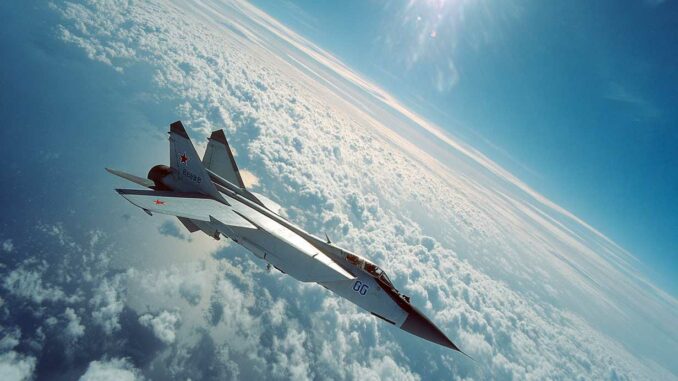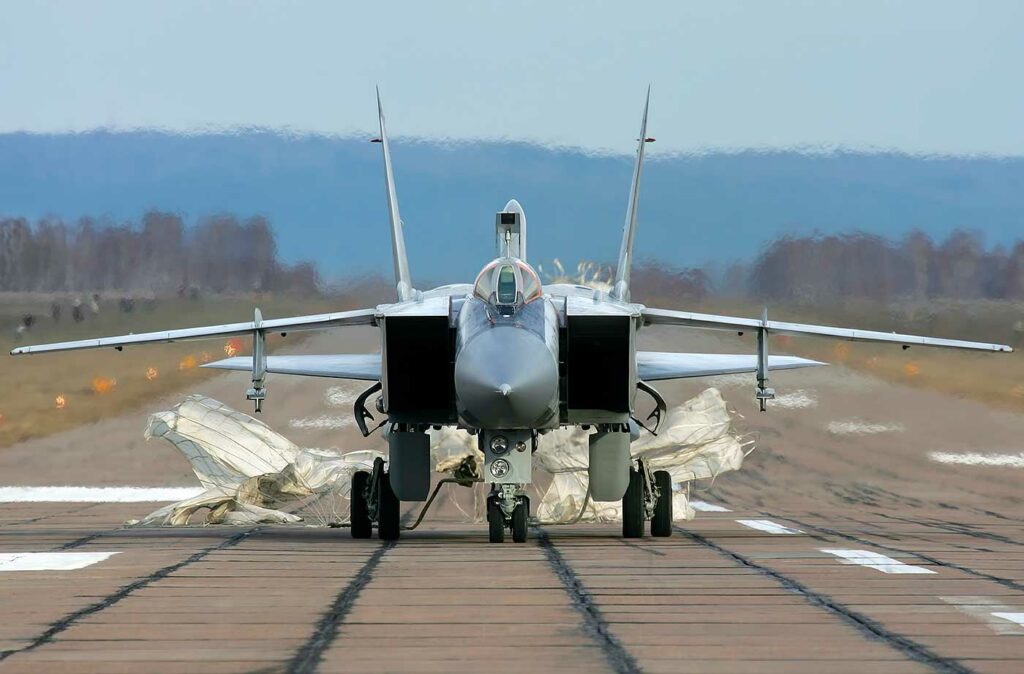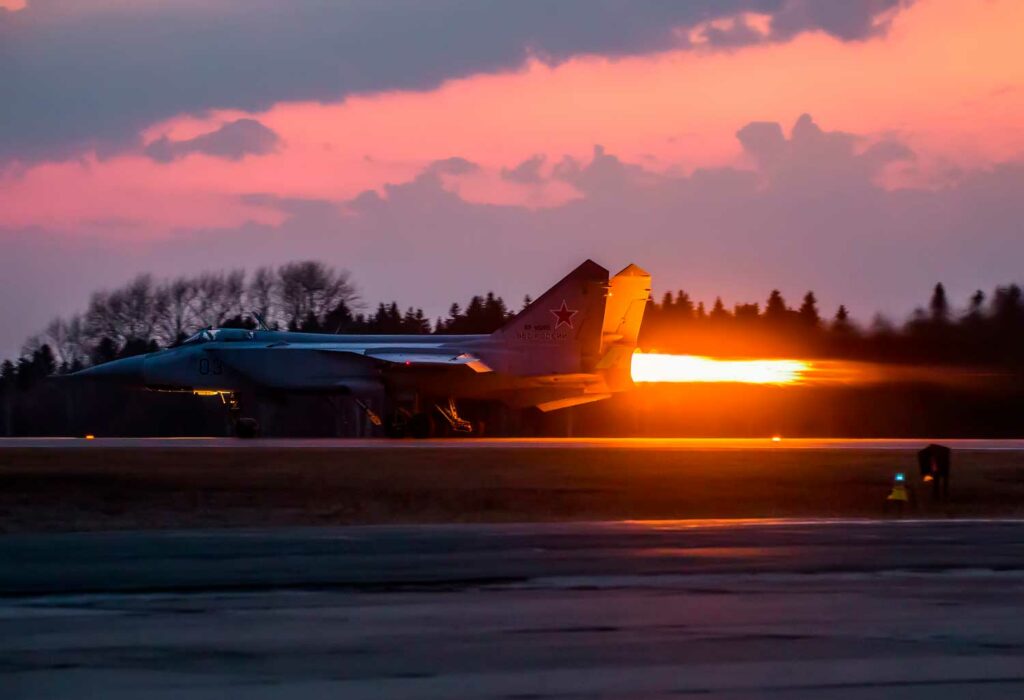
Capable of operating at 21,000 meters, the MiG-31 can intercept missiles, satellites, and spy planes above civilian airspace.
Developed by the Soviet Union in the 1970s, the MiG-31 is not a conventional fighter jet. This twin-engine, two-seater aircraft is a heavy interceptor designed to operate at high speeds and very high altitudes. Its operational ceiling exceeds 20,000 meters, placing it well above civilian air traffic, which generally operates between 9,000 and 12,000 meters. At this altitude, the MiG-31 becomes a strategic tool, capable of detecting and neutralizing threats that few aircraft can reach.
Designed to counter cruise missiles, stealth bombers, and reconnaissance aircraft such as the Lockheed SR-71 Blackbird, it meets strict technical specifications, developed in the context of direct confrontation between the USSR and the United States. Even today, despite its age, it remains in service with the Russian forces, modernized and re-equipped to adapt to evolving threats. One of its major advantages is its ability to operate at the edge of the stratosphere, with speed and radar power unmatched by most Western fighters. This extreme operational altitude is not just a number, but a tactical asset in its own right.

An exceptional operational ceiling for specific missions
A cruising altitude well above military standards
The MiG-31 has a flight ceiling of between 20,600 and 21,500 meters, according to official Russian sources. This capability places the aircraft in a class of its own, with performance comparable to that of certain American experimental aircraft such as the U-2 and SR-71. At this altitude, the air is extremely thin: atmospheric density is only about 7% of that at sea level, requiring careful aerodynamics and powerful engines.
The D-30F6 engines, developed by Soloviev, provide a unit thrust of 15,500 kg, enabling the MiG-31 to reach a speed of Mach 2.83. At this speed and altitude, few targets are out of range. The aircraft retains its detection and attack capabilities even where most conventional radars begin to lose effectiveness.
This operational altitude gives the MiG-31 a real tactical advantage, particularly when intercepting targets flying at high altitude or at very high speeds. These include hypersonic vehicles, satellites in descent, and strategic drones operating at the edge of space.
Intercepting what others cannot reach
One of the original objectives of the MiG-31 was to be able to intercept the SR-71 Blackbird, which operated at an altitude of approximately 24,000 meters and at speeds of over 3,500 km/h. Although the MiG-31 could not match these performance figures, its combination of speed, altitude and long-range missiles enabled it to shoot down a target even if it remained out of direct range. The use of R-33 and then R-37 missiles, with a range of over 300 km, allows the MiG-31 to act from a distance, before the enemy can even respond.
Its ability to operate at these altitudes also allows it to track ballistic trajectories and intercept cruise missiles or stealth aircraft with very low radar signatures. Its Zaslon-M radar, with a diameter of 1.4 meters, is optimized to operate in these extreme conditions, with a theoretical range of up to 400 km against air targets.

A strategic role in territorial defense
A Soviet response to American electronic warfare
The altitude at which the MiG-31 operates is not just a technical achievement. It was part of a well-established doctrine: the deep defense of Soviet territory. In the event of conflict, the United States was expected to launch B-52 bomber raids or cruise missile attacks. The MiG-31, on alert in remote areas of Siberia, was tasked with intercepting these threats before they entered critical airspace.
The high altitude of interception also allows certain jamming measures to be bypassed. Many electronic warfare systems are optimized for medium altitudes. By operating above these layers, the MiG-31 reduces their effectiveness. It can thus pick up radar and infrared signals with less interference.
Russia still exploits this strategic capability today, maintaining a number of MiG-31s in permanent rotation in the Arctic and Far East regions, where ground-based radar coverage remains incomplete. At 21,000 meters, a single MiG-31 can monitor a territory with a radius of over 1,000 km, depending on its position and weather conditions.
A doctrine that remains relevant with modernized versions
The MiG-31B and MiG-31BSM have been gradually modernized to extend their service life beyond 2040. The most advanced versions, such as the MiG-31K, now carry the Kh-47M2 Kinzhal hypersonic missile, capable of striking targets over 2,000 km away. This integration was only made possible by the MiG-31’s ability to operate at high altitudes and high speeds, which is essential for the effective launch of the Kinzhal.
The MiG-31’s strategic role in long-range interception missions, but also in projecting power from national territory, is therefore still relevant today. Unlike Western multirole fighters, the MiG-31 does not seek versatility but efficiency in a very specific niche: superiority in the upper atmosphere.

A unique capability in the global airspace
No equivalent alternative in Western forces
Today, no Western interceptor is capable of reaching and maintaining such an altitude in an operational manner. The F-15, F-22 and Eurofighter generally have a ceiling of around 16,000 to 18,000 meters. Experimental programs such as the American SR-72 have not yet seen the light of day. The MiG-31 therefore retains a unique role in Russia’s air defense arsenal.
Its speed and altitude make it difficult to intercept. A conventional fighter would take several minutes to reach such altitudes, with high fuel consumption and a loss of maneuverability. In comparison, the MiG-31 can maintain Mach 2.3 in cruise, allowing it to patrol huge areas without refueling.
Its effectiveness is based on a combination of extreme factors: speed, altitude, long-range radar, and weaponry capable of acting well before any direct threat. This makes it a deterrent, but also a vehicle for immediate response, where ground-to-air or satellite systems would have a slower response time.
War Wings Daily is an independant magazine.